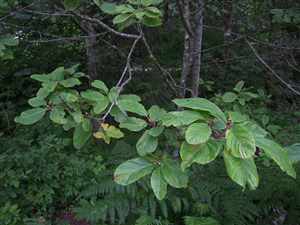Cascara Sagrada (Frangula purshiana, Rhamnus purshiana)
Main Facts about Cascara Sagrada

Cascara Sagrada is a deciduous tree or shrub, 5 to 25 feet tall with thin dark-green leaves with serrated edges, umbels of greenish yellow flowers followed by small scarlet to black berries, and reddish brown bark. Parts used – bark.
Seventeenth-century Spanish explorers named it Cascara Sagrada (“sacred bark”), perhaps because of its value to Native Americans as a medicinal plant. The most important use of the distinctive reddish gray bark was as a laxative. Settlers to the West learned to make a tea by soaking a piece of the dried bark in cold water overnight.
In 1877, the pharmaceutical company Parke-Davis first marketed the herb, and a year later, the company introduced a liquid extract of Cascara bark as a treatment for constipation.
Using Cascara Sagrada
Cascara Sagrada contains chemicals called anthraquinones that stimulate the intestinal contractions known as the urge. The herb is milder than some other anthraquinone laxatives, like Aloe, Buckthorn, or Senna. Compared with these plants, Cascara is less likely to cause nausea, vomiting, and intestinal cramps, although these reactions are still possible. The tree’s bark contains a gentle laxative that stimulates contractions of the large intestine, helping to move food through the digestive system. In 2002 the FDA issued a ban on over-the-counter stimulant laxative drug products that contain Cascara Sagrada. As a result, you can no longer buy over-the-counter laxatives that contain Cascara Sagrada. However, it’s still available as an ingredient in some prescription laxatives and as an herbal supplement. Like other stimulant laxatives, it can cause abdominal cramping, loss of electrolytes, and dependency. Using Cascara Sagrada for longer than two weeks can lead to “lazy bowel syndrome”. This condition prevents you from having bowel movements without the help of a laxative. To prepare a decoction, boil 1 tsp of well-dried bark in 3 cups of water for 30 min, then strain and let cool. Drink 1-2 cups a day.Cascara Sagrada is a remedy for: Constipation
How to grow Cascara Sagrada
A shrub of a small tree, Cascara Sagrada grows in moist, fertile soil and full sun to partial shade. It can be propagated by seed, layering, or cutting. For medicinal use, harvest the bark in spring or fall. Before use, cure the bark for at least a year. Aging is essential because consuming the fresh bark can cause vomiting and intestinal spasms.| Cardamom |
Catnip
|